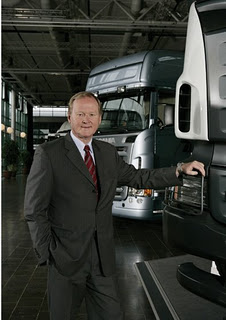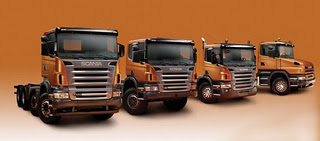There are suitable macro-economic conditions for continued expansion in commercial vehicle demand. In the next several years, the annual growth in mature economies is expected to be about two per cent, while the economies of emerging Europe, Asia, Northern Africa and Southern Africa are projected to expand by six per cent yearly. These fast-growing markets will be increasingly important to Scania, which expects this trend to be lasting.
“We will reach 150,000 vehicles by continuing to expand in a smart and cost-effective way. We can produce this many vehicles by 2015 using our existing production structure. With fewer production employees, today we manufacture twice as many vehicles as 15 years ago,” said Mr. Leaf Östling, Scania President and CEO.
He emphasized the strength that Scania derives from continuing to work according to its three core values – customer first, respect for the individual and quality. “A company that works in this way tends to be successful. That is also the case with Scania.”
Continued market growth and increased market share are the basis of Scania’s vision for 2015, but it will also depend on entering new segments and markets.
“Our growth strategy is based on finding customers, segments and product applications in all markets where Scania’s business model yields advantages. We focus on customers who demand vehicles with high productivity throughout their life cycle. We promise our customers the highest uptime at the lowest operating cost,” said Mr. Martin Lundstedt, Head of Franchise and Factory Sales.
Europe will remain Scania’s most important market in 2015. Here Scania foresees an annual sales potential of 95,000 vehicles (heavy trucks and buses) in a total market that will grow to 575,000 vehicles. The largest growth will occur in central and eastern Europe, including Russia, where continued expansion of infrastructure and greater prosperity will lead to high demand that last long.
Scania also expects the Latin American market to grow, reaching 180,000 vehicles per year. Here the company sees potential for annual sales of 16,000 vehicles in 2015. The largest growth is expected in the agricultural and mining sectors, but demand will also increase at the pace of economic expansion.
Asia and the Pacific are of increasing importance to Scania, which estimates its annual sales potential at 15,000 vehicles around 2015. Scania’s growth will primarily occur in segments where there is demand for efficient transport and for vehicles with high technology content, good performance and high uptime. These will mainly include vehicles for oil and chemical transport, mining and construction.
The growing markets of the Middle East, India and Africa are projected to total 430,000 vehicles per year in 2015. Demand is driven mainly by infrastructure investments in the Middle East and in Northern and Southern Africa. In these regions, Scania sees sales potential of 25,000 vehicles.
Doubling of service business
In Scania’s scenario for 2015, the number of Scania vehicles in operation around the world will have increased to one million. “This will mean a doubling from the level we have today. Taking care of them represents a major challenge for our service organisation,” said Urban Erdtman, Head of Sales and Services Management.
The challenge also includes meeting customer demands for greater uptime. Scania is thus continue to expand one-stop shopping, which means providing customers with service not only for their vehicles but also tyres, trailers and superstructures, as well as various services such as financing, transport planning and driver training.
“To meet greater customer demand and be able to take care of a doubled vehicle volume, we expect to continue annually investing SEK 1 billion in our own sales and service organisation and expect that our franchisees will be making investments on the same scale,” Mr. Erdtman said.
“In order to grow our business towards 150,000 vehicles, we must also offer a broader range of models and give customers greater opportunities to tailor their vehicles to their own needs,” declared Hasse Johansson, Scania’s Head of Research and Development.
Scania is continuing to expand its ReadyBuilt concept, which involves working closely with selected suppliers and being able to deliver complete vehicles including superstructures, for example construction haulage trucks, with short lead times. It is making extensive efforts to maintaining its prominent position in terms of environmental performance and engines that can run on renewable fuels as well as in hybrid technology.
“Reducing carbon dioxide emissions is a challenge, but also a business opportunity. I am convinced that we can halve such emissions by 2020,” Mr. Johansson said.
Mr. Per Hallberg, Scania’s Head of Production and Procurement, explained how the company would achieve annual capacity of 150,000 vehicles by around 2015.
“This implies that we will boost production capacity by 10,000-12,000 vehicles per year. The increase can be accomplished with limited investments in our existing production structure, and we will achieve it without sacrificing quality and delivery precision,” he said.
Scania’s 2006 decision to concentrate on European axle and gearbox production in Södertälje laid the groundwork for production capacity of 100,000 vehicles by the end of 2009. By outsourcing non-strategic components, it has reduced its in-house added value to about 30 per cent of total production cost. Meanwhile this has meant a more flexible cost structure.
